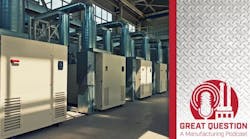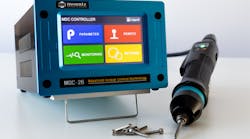Large factories making small products have dozens, if not hundreds, of separate workstations. This modular arrangement serves a dual purpose. For one, large product orders can be completed quickly by bending the entire factory to their production. But, since not every order is a behemoth, this arrangement also allows you to complete separate small orders at the same time.
You can arrange various other combinations as well. For instance, 80% of a factory’s workstations can be set up for a single large order while the remaining 20% handles one, two, or more small orders. This separation into a network of individual workstations ensures that, so long as there are product contracts to fulfill, no workstation needs to sit idle.
In order to successfully manage so many workstations, it’s important to be able to control many stations from a single node. If multiple screwdrivers are connected to the same torque controller, it’s possible to program them all at the same time. This way, when it’s time to switch to a new production sequence, you won’t lose much time reprogramming. This also enhances repeatability, as each automated screwdriver under the same controller will deliver the same results.
The Benefits of Using Torque Controllers for Multiple Robotic Workstations
Using torque controllers to manage multiple workstations is particularly important for complex, high-volume manufacturing. Companies often manufacture products which require multiple fastening passes or sequences involving many screws with different torque requirements.
As the assembly grows more and more complex, programmable robotic assembly tools demonstrate greater advantages over human tool operators in terms of speed and reliability. While human workers are highly effective at assembly operations requiring critical thinking and problem solving, robots are better at repeating the same motions over and over without making mistakes or suffering injury. Still, in order to efficiently program a large number of robotic arms, it’s best to be able to program them all from one or a few locations.
Not only does this cut down on programming time and increase repeatability, but it also improves a factory’s ability to monitor production and collect data. Monitoring production allows any issues, such as tools slipping out of calibration or a rise in cross-threading or omissions, to be detected and corrected in real-time. The speed of this response reduces rework and lost product, thereby improving a manufacturer’s reputation and their ability to complete contracts.
Collecting data creates traceability, ensuring that any problems detected after production can be followed back to their source and corrected for future assemblies. It also allows manufacturers to easily trace their products by workstation. If one workstation produced faulty products for a few shifts or longer, manufacturers can easily isolate products created during that time for rework or recall.
Companies manufacturing high volumes of products need to work at high speed while committing few or no errors. The most effective method of fastening screws or bolts under these conditions is employing electric screwdriverson robotic arms. And these robotic arms, in turn, should be managed by torque controllers running multiple workstations. These computerized systems work quickly, precisely, and with a high degree of repeatability. Investing in torque controllers capable of simultaneously managing multiple workstations will enhance a company’s ability to effectively manufacture high-volume products.










